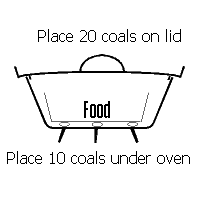Equipment Hints: Dutch Oven Use & Propane Stove Use
by Kathy and Bruce Jacobs
The Best Way to Dutch Oven
Over the years, we have cooked hundreds of dishes in Dutch Ovens. We have developed a technique for using the ovens that makes the cook's life much easier.
What is this technique? Simple. Set up your dutch oven as shown in this diagram:

To use this technique, keep the following hints in mind:
- Use a liner pan. This can be anything from a foil pan to a cake pan to any pan that fits in your Dutch Oven. Putting your food in the liner pan allows air circulation around the sides of the food as it cooks. Air flow results in more even heating, which in turn gives better end results. Using a liner pan also minimizes your clean up, as most times you clean the pan, not the Dutch Oven. In a pinch, you can use foil. However, realize that foil does not allow air flow as well as a liner pan.
- Use spacers. The spacers lift your liner pan off the bottom of your Dutch Oven. When the food doesn't touch the bottom of the oven, you get three great results: air flow in all directions, less surface area of the food touching the oven, and more heat diffussion. When you combine these three, you end up with recipes that cook evenly and don't burn.
- Put more coals on the top of the oven than on the bottom. Generally, for recipes calling for a 350 degree oven, you would use 20 coals on top of the oven and 10 on the bottom.
- Place an oven thermometer on the top of the Dutch Oven. It will report the temperature inside the oven, allowing you to control the temperature much better.
- Do not overfill the Dutch Oven. The more food in the oven, the longer it takes to heat. If you overfill the Dutch Oven, you reduce air flow, reducing the heat, and increasing the cook time. For example, a five pound meatloaf will take much longer to bake than two meatloaves of a two and a half pounds baked separately.
Using this technique of Dutch Oven cooking, you turn your Dutch Oven into a convection oven. The food stays moist while cooking and cooks more evenly.
All of the Dutch Oven recipes I write have been developed to use this method. If you do not use the method described above, your results will vary.
The Best Way to Propane Stove
Propane stoves heat food in the same manner as gas stove tops. Investing in one or two good propane stoves will decrease your cook time and increase your enjoyment of the stove.
First, always spend the money to get a stove with a back and sides. The number one problem with cheap stoves is that they have nothing to stop air flow around the flame and the food. The flame will not go out in most storms if the stove is not protected, but the wind will remove much of the heat from the flame before it reaches your food.
Buy renewable or refillable propane tanks. Yes, they weigh more, but they end up costing less and are much better for the environment. We generally use large tanks for our own cooking and both for classes.
If you must use disposable propane tanks, do not tighten them too far. The gas flow from the tanks is controlled by a small metal piece that deforms easily. Once it deforms, the tank no longer has a good shut off valve. If this occurs, you will hear a hissing sound coming from the tank when you remove it from the stove. In this case, reattach it to the stove valve, if possible. Don't leave it connected to the stove though! Then, dispose of the gas when you get home.
